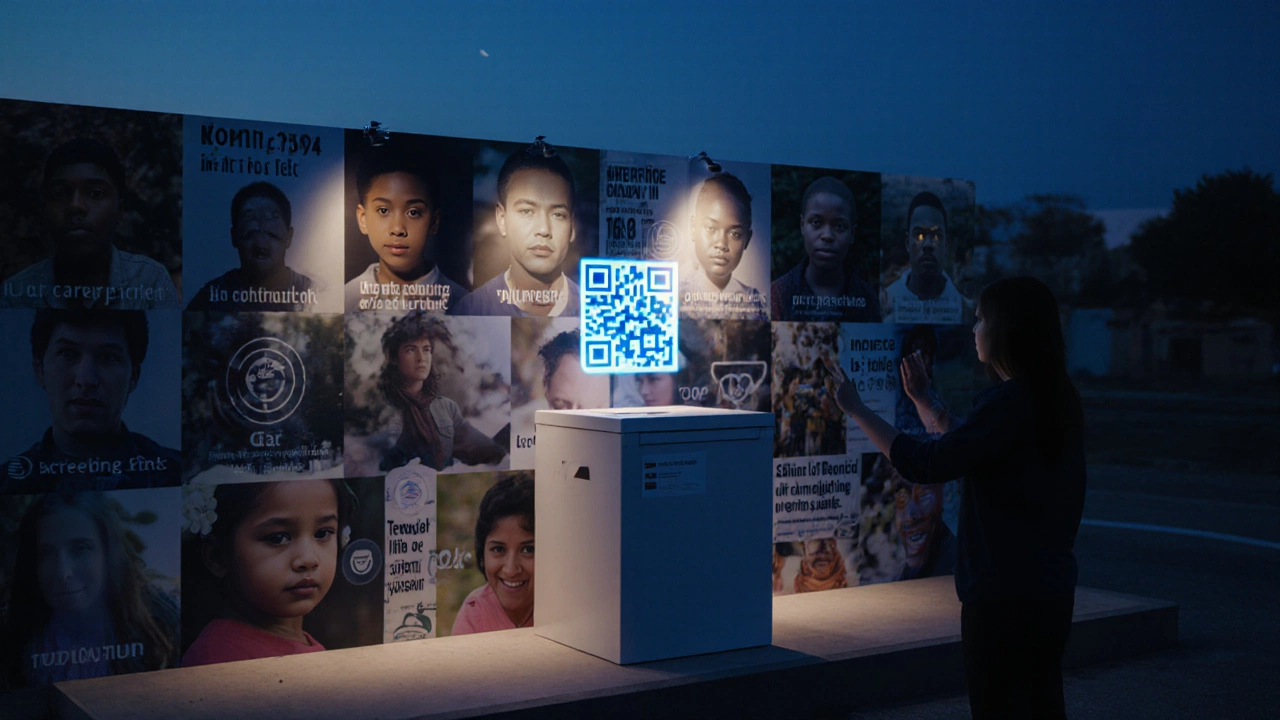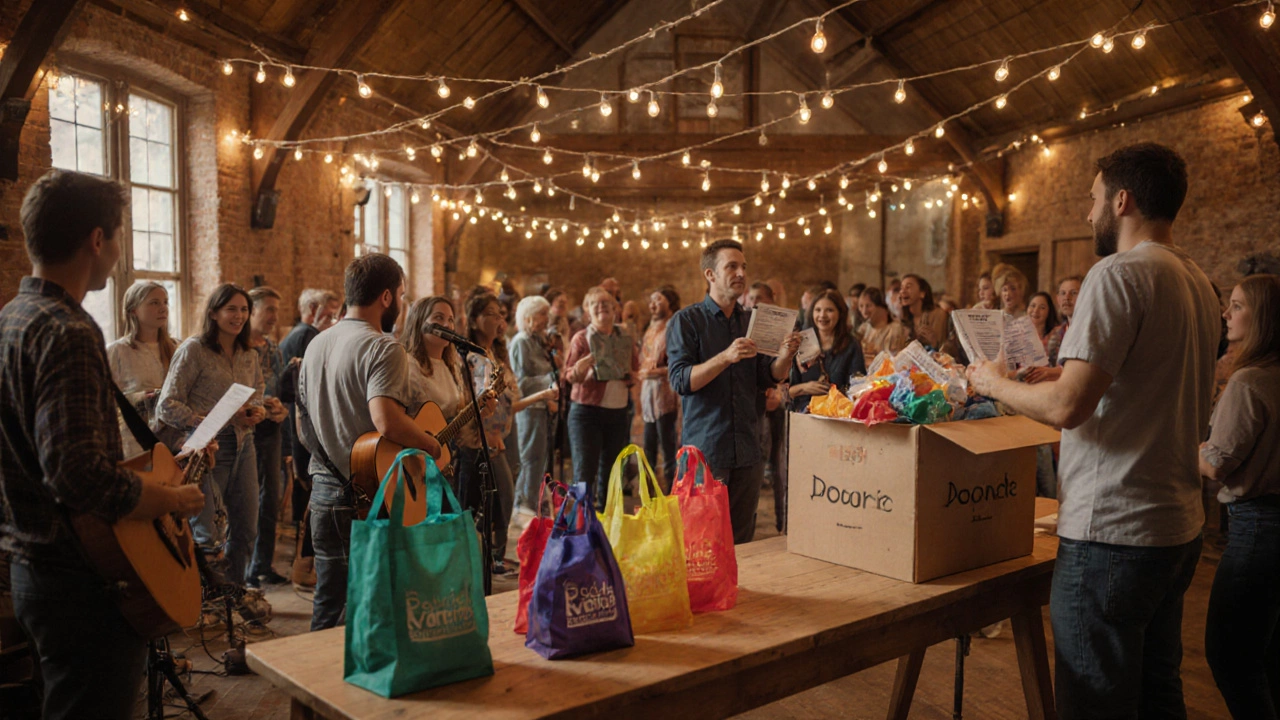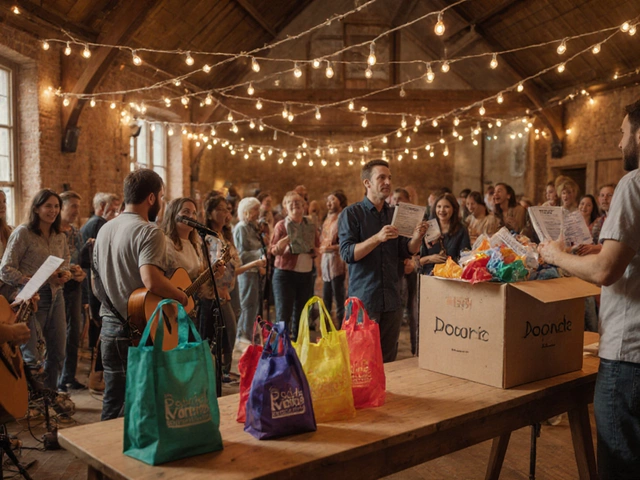Charity Event Revenue Estimator
Revenue Streams Calculator
Estimate potential earnings from different revenue streams for your free charity event. Enter your expected values and see projected revenue totals.
Sponsorship
Merchandise Sales
Workshops
Food & Beverage
Raffles & Auctions
Donations
Revenue Breakdown
Note: These estimates are based on your input values. Actual revenue may vary based on event execution, market conditions, and other factors.
The article provides more details on how to maximize each revenue stream for your event.
Picture this: a bustling community hall, music filling the air, volunteers hustling, and nobody paid a cent to get in. Yet by the end of the night, the donation box is overflowing and the bank account shows a tidy profit. That’s the magic of turning a Free Charity Event an event that charges no admission fee but aims to raise funds for a cause. Below is a step‑by‑step playbook that shows exactly how to make money from free event without compromising the spirit of giving.
1. Map Your Revenue Streams Before the First Guest Walks In
Start with a simple spreadsheet that lists every possible way to earn money. Typical categories include Sponsorship financial support from businesses in exchange for brand exposure, Crowdfunding online campaigns that let supporters donate ahead of the event, and Merchandise Sales selling branded tees, mugs, or tote bags at the venue. Add secondary streams like Ticketed Workshops educational sessions with a small fee, even if the main event is free or Food & Beverage Sales concessions, snack stalls, or a paid coffee corner. Having a clear map lets you allocate resources confidently.
2. Secure Sponsors That Align With Your Cause
Approach local businesses, larger corporations, and even online brands whose values match the charity’s mission. Offer tiered sponsorship packages: a “Gold” level might get a banner on the stage, a logo on every flyer, and a shout‑out during the opening speech. A “Silver” tier could include a booth space and social‑media mentions. Make a concise sponsorship deck that highlights audience demographics (e.g., "500 community members, 60% families, average spend $35"). Real‑world example: a Wellington café partnered with a local environmental clean‑up event, providing coffee in exchange for brand placement, and walked away with $2,200 in net profit.
3. Leverage Crowdfunding to Build Momentum Early
Launch a micro‑campaign on platforms like Givealittle or GoFundMe a month before the event. Offer perks such as a name on the donor wall, early access to raffle tickets, or a limited‑edition T‑shirt. The key is transparency: share a budget breakdown showing exactly how each dollar helps the cause. A well‑crafted story can attract donations from people who cannot attend the event but still want to support it.
4. Turn Merchandise Into Mobile Advertising
Design simple, eye‑catching items that feature the event logo and cause slogan. Use on‑demand services like Printful to keep upfront costs low; you only order what you sell. Price items at a 50‑70% markup to ensure a healthy margin. Successful case: a charity bike‑ride sold custom water bottles for $15 each, netting $1,800 after production costs.
5. Offer Paid Workshops or Mini‑Classes
Even if the headline event is free, attendees love learning something new. Book a local expert to run a 45‑minute session on, say, “DIY Upcycling Projects” and charge $10 per seat. Limit spots to create scarcity, and promote the workshop as a “must‑see” part of the evening. The revenue from a 30‑person workshop often covers the speaker fee and adds a tidy profit.
6. Set Up Food & Beverage Stations With a Margin
Partner with a community kitchen or a food truck that agrees to share a percentage of sales. If you hold the licensing, you can keep 70% of the profit. Simple items like popcorn, hot chocolate, or a local cheese platter have low overhead and high mark‑up. Remember to obtain any necessary permits from the Wellington City Council.
7. Add Fun Fundraising Games: Raffles and Auctions
A Raffle a game where participants buy tickets for a chance to win donated prizes is a classic. Secure appealing prizes-gift baskets, restaurant vouchers, or a weekend getaway. Price tickets at $2 or $5 and sell them throughout the event. An Auction live or silent bidding on items, often raising more than the item's retail value can be done with donated artwork or experiences. Both tactics work best when you build excitement with a countdown timer.
8. Create a Donation Station With a Storytelling Edge
Set up a clearly marked donation box next to a photo wall that tells the impact story-real images of beneficiaries, short testimonials, and clear metrics (e.g., "$1 feeds a child for a day"). Offer a QR code for digital donations, catering to the cash‑less crowd. Giving people a tangible connection to the cause often turns a casual passerby into a donor.

9. Compare Revenue Streams - Which One Fits Your Event?
| Stream | Setup Cost | Potential Yield | Risk Level |
|---|---|---|---|
| Sponsorship | Low (proposal creation) | High (depends on sponsor size) | Medium (requires negotiation) |
| Crowdfunding | Low (online platform fees) | Medium (depends on outreach) | Low (no upfront spend) |
| Merchandise Sales | Medium (design & stock) | Medium‑High (markup) | Medium (unsold inventory) |
| Food & Beverage | Medium (permits) | Medium (volume driven) | High (health regulations) |
| Raffle / Auction | Low (prize sourcing) | Medium (ticket sales) | Low (simple to run) |
10. Build a Timeline - From Planning to Post‑Event Wrap‑Up
- 12 weeks out: Set goals, pick a venue, and lock in a cause.
- 8 weeks out: Secure sponsors, launch crowdfunding, design merchandise.
- 4 weeks out: Confirm food partners, recruit volunteers, print promotional material.
- 2 weeks out: Order merch, finalize raffle prizes, test donation QR codes.
- Event day: Open donation stations early, run workshops, keep a running tally on a screen.
- 24‑48 hrs after: Thank sponsors publicly, share final figures, and post photos.
Following a timeline keeps the team focused and ensures every revenue source gets the attention it deserves.
11. Avoid Common Pitfalls
- Over‑promising to sponsors: Deliver exactly what’s agreed‑upon; otherwise future partnerships suffer.
- Under‑pricing merchandise: Do a quick cost‑plus calculation; aim for at least a 50% margin.
- Skipping permits: Food stalls and raffles often need council approval-don’t assume it’s optional.
- Neglecting digital donations: A QR code with a short URL can add 10‑20% more cash.
12. Measure Success and Iterate
After the event, compare actual revenue versus the projections you set in the spreadsheet. Identify which streams exceeded expectations and which fell short. Use this data to tweak your next event’s budget. Over time, you’ll develop a reliable formula that turns any free gathering into a fundraising powerhouse.
Can I charge for any part of a free charity event?
Yes. While the main admission stays free, you can charge for add‑ons like workshops, merchandise, or food. Just be transparent about what’s optional.
How much should I ask sponsors to contribute?
It depends on audience size and exposure. A small local business might give $200 for a banner, while a regional company could offer $5,000 for headline sponsorship.
What legal considerations are there for raffles?
In New Zealand, raffles are regulated under the Gaming Act. You must obtain a licence if ticket sales exceed a certain threshold and ensure prizes are clearly described.
How do I promote the event without a big budget?
Leverage community groups, local social media pages, and partner newsletters. Encourage volunteers to share with their networks and use free design tools for eye‑catching flyers.
Is it okay to mix free admission with a ‘pay‑what‑you‑want’ model?
Absolutely. A ‘pay‑what‑you‑want’ box at the exit lets people contribute based on their experience, often raising more than a fixed ticket price.


